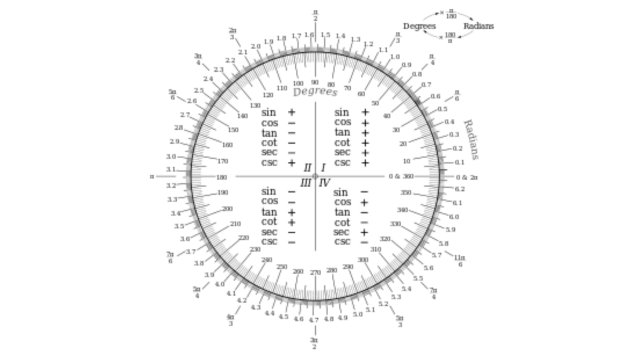Degree (angle):-
A degree, in the context of geometry and trigonometry, is a unit of measurement for angles. It is denoted by the symbol °. One complete revolution around a circle is divided into 360 degrees. Each degree is further subdivided into minutes (denoted by ‘) and seconds (denoted by “), where 1 degree is equal to 60 minutes and 1 minute is equal to 60 seconds.

For example:-
1 degree = 60 minutes
1 minute = 60 seconds
So, 1 degree is equal to
1
360
360
1
of a complete revolution.
Degrees are commonly used to measure angles in various fields including mathematics, engineering, navigation, and astronomy. They provide a standardized way to express the size of an angle and are widely understood across different disciplines.
Degree (angle) History:
The history of the degree as a unit of measurement for angles dates back to ancient civilizations. The concept of dividing a circle into smaller parts to measure angles has been prevalent for thousands of years.
Here’s a brief overview of the history:-
The concept of angles and their measurement can be traced back to ancient civilizations such as the Babylonians, Egyptians, and Greeks. These civilizations used various methods to measure angles, often based on geometric principles and observations of celestial bodies. The Babylonians, around 400 BCE, used a sexagesimal (base-60) system for measuring angles. They divided a circle into 360 degrees, which is still the standard today.
Greek mathematicians, including Hipparchus and Ptolemy, further developed the concept of angles and refined methods for measuring them. They contributed significantly to trigonometry, which deals with the study of angles and triangles. During the Islamic Golden Age (8th to 14th centuries), Muslim scholars made significant advancements in mathematics and astronomy. They adopted and expanded upon Greek knowledge, contributing further to the development of trigonometry.
The degree measurement system, as we know it today, became more standardized during the European Renaissance. Mathematicians and astronomers, such as Johannes Kepler and Tycho Brahe, made important contributions to trigonometry and celestial observation, solidifying the use of degrees as a standard unit for measuring angles.
Degrees remain the most commonly used unit for measuring angles in modern mathematics, science, engineering, and everyday life. They provide a convenient and standardized way to express angular measurements across various disciplines.
Overall, the history of the degree as a unit of angle measurement reflects centuries of mathematical and scientific development, drawing upon the contributions of ancient civilizations, medieval scholars, and Renaissance thinkers.
Also Read: Names of 12 Top Best Hospitals in Chennai for Exceptional Medical Care
Degree (angle) Subdivisions:
Degrees, as a unit of angle measurement, can be subdivided into smaller units called minutes and seconds.

Here’s how these subdivisions work:
1. Minutes (‘): Each degree is further divided into 60 minutes. Minutes are denoted by the symbol ‘ (apostrophe). So, 1 degree = 60 minutes. Minutes are used to express angles that are smaller than a degree but larger than a second.
2. Seconds (“): Each minute is further divided into 60 seconds. Seconds are denoted by the symbol ” (double apostrophe). So, 1 minute = 60 seconds. Seconds are the smallest unit of measurement for angles and are used to express very precise angles, especially in fields like astronomy and navigation.
For example:-
An angle of 30 degrees, 15 minutes, and 45 seconds would be written as 30° 15′ 45″.
Similarly, an angle of 45.5 degrees can be expressed as 45° 30′.
These subdivisions provide a finer level of detail when measuring angles, allowing for more precise calculations and representations in various fields such as astronomy, engineering, geography, and navigation.

